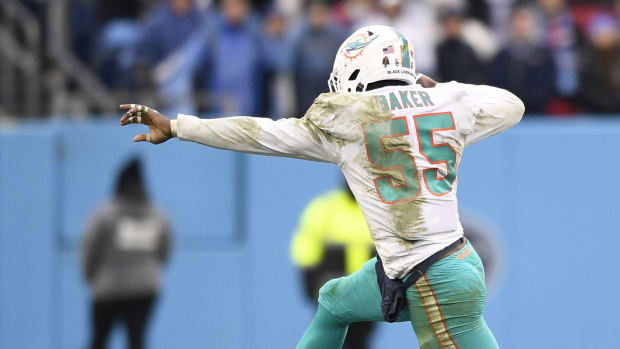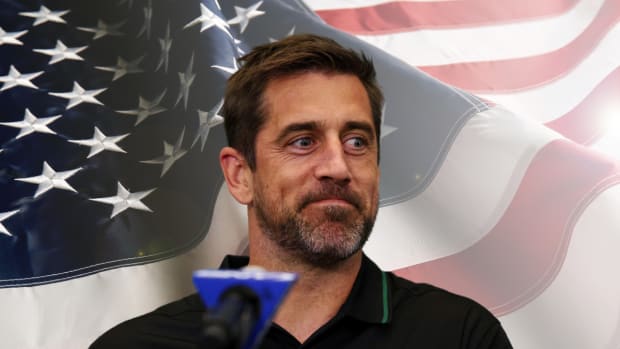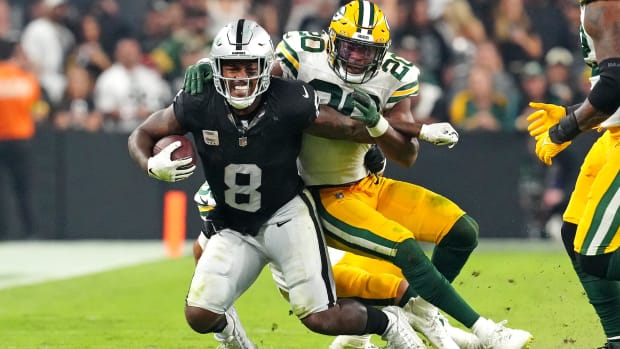World’s Best Preview: Living and Dying (?) By Big Plays on Defense
At some point in an NFL season, you are who you are.
Defensively through eight games, the Green Bay Packers are a big-play unit. Entering Week 9, the Packers are sixth with 14 takeaways, third with 12 sacks on third or fourth down and fourth with 39 passes defensed.
However, they’ve also given up big plays. Far too many big plays.
The Packers entered this week ranked 22nd in explosive plays allowed per game. Defensive coordinator Mike Pettine considers a run of more than 10 yards and a pass of more than 15 yards to be explosive. The Packers are allowing 8.0 explosives per game, including a ghastly 6.0 explosive passes per game.
“I think we’ve just got to make sure we’re playing disciplined football,” Packers coach Matt LaFleur said. “You look at last week, we knew we were playing an explosive team and we knew we had to be disciplined with our eyes, disciplined with our assignments, and that didn’t always happen. That’s what happens when you’re not. I just think it comes back to playing good, fundamentally sound, disciplined football. Making sure you’re knowing what to do and trusting. I think trust is a big part of it. Trust in that the other 10 guys are doing what they need to do.”
It doesn’t take a football aficionado to figure out the impact of big plays. The math is simple. It takes four plays of 5 yards to move the ball the same distance as one play of 20 yards. Make the opponent move the ball a few yards at a time and the odds turn in the defense’s favor that either the offense will mess up or the defense will make a play to create second- or third-and-long.
The Packers have allowed 48 completions of more than 15 yards, with those plays totaling 1,330 yards. Those plays represent a whopping 66.0 percent of the 2,014 net passing yards allowed. On the other hand, the other 248 passes and sacks have gained 684 yards.
On a down-to-down basis, Green Bay is playing winning defensive football. It’s the play here and there that’s troubling. Sometimes, such as the touchdown last week by Kansas City tight end Travis Kelce, it's a blown assignment. Sometimes, such as the touchdown last week by Kansas City receiver Mecole Hardman, it's bad tackling. Sometimes, such as against Dallas receiver Amari Cooper, it's simply a quarterback and receiver making some plays. Coaches can live with that third scenario; it's the first and second that drive them crazy.
“It’s easy to say, if you just take out these five plays, it’s 150 yards. But I understand your point,” Pettine said. “It’s not like we’re steadily giving up chunks and even bigger ones. For big stretches of the game, we are playing how we want to play. We’ve talked about it in our room. We are where we are record-wise and we’re thrilled about that, but the positive thing is our guys know how much better we can be. And that’s at the heart of it is making sure guys understand. We talk about doing your job doing your 1/11th. A big part of doing your job is knowing your job. So, that’s the prep part of it is a big, and then it’s having the ability to go out and execute on a big stage. We just hadn’t been consistent enough.”
The question is, will the Packers actually get to that point where they can limit those explosive passing plays? Because they’ve been trending the wrong direction in that regard.
Green Bay started the season by allowing four to Chicago, five to Minnesota, five to Denver and three to Philadelphia. That’s 4.25 explosive passes per game in the first quarter of the season. However, it yielded 10 to Dallas, five to Detroit, nine to Oakland and seven to Kansas City. That’s 7.75 explosive passes per game in the second quarter of the season. Green Bay allowed two explosive passing touchdowns in the first four games but five in the next four games.
After a red-hot start to the season, it’s possible teams have partially solved Pettine’s defense. If that’s true, it could be schedule-related. In Week 5, Detroit was coming off its bye. In Week 6, Oakland was coming off its bye. In Week 7, Kansas City was coming off its mini-bye following a Thursday night game. That means extra time for film study and game planning.
“We’ve had some tendencies broken, but I don’t think that would be a major thing,” Pettine said. “I think maybe more rested players would have more of an influence, more of an impact than necessarily just the extra time to prepare and scheme for us. That has something to do with it. But it’s just hard to quantify what the impact was.”
The scheduling disadvantages are over. The Packers and Chargers will be on equal footing on Sunday in Carson, Calif. The Chargers’ Philip Rivers, who has tormented the Packers in each of his three previous starts, is tied for the NFL lead with 51 explosive completions and star receiver Keenan Allen is fifth with 16 explosive receptions.
Maybe Green Bay can work out the kinks during the final eight games. Looking at the upcoming schedule, Carolina (33 explosive passes), San Francisco (30 before Thursday night’s win over Arizona), the New York Giants (37), Washington (26) and Chicago (26) are all below the league average of 38 explosive passes. However, the regular season concludes against Minnesota (41) and Detroit (42). And, if the Packers get there, potential playoff games loom against the Rams (48), Seahawks (44), Cowboys (41), Vikings and Saints (40, despite the absence of Drew Brees).
Through a half-season, the Packers have fielded a big-play defense. Is that identity locked into place? Are the Packers simply going to be a team that lives by the big plays it makes but will eventually die because of the big plays it allows?
“Looking forward to the second half of the year,” Pettine said, “if you can get that cleaned up, then we think that we can be significant and better.”
Explosive plays allowed
(Defensive coordinator Mike Pettine defines an explosive play as a rush of more than 10 yards and a pass of more than 15 yards. Teams are listed in order of explosive plays allowed per game.)
San Francisco: 15 rush, 18 pass. 33 total. 4.7 per game.
New England: 13 rush, 30 pass. 43 total. 5.4 per game.
Chicago: 10 rush, 29 pass. 39 total. 5.6 per game.
Tennessee: 11 rush, 37 pass. 48 total. 6.0 per game.
Pittsburgh: 10 rush, 33 pass. 43 total. 6.1 per game.
Minnesota: 16 rush, 34 pass. 50 total. 6.3 per game.
Buffalo: 22 rush, 22 pass. 44 total. 6.3 per game.
Denver: 19 rush, 35 pass. 54 total. 6.8 per game.
New Orleans: 17 rush, 37 pass. 54 total. 6.8 per game.
L.A. Chargers: 20 rush, 35 pass. 55 total. 6.9 per game.
L.A. Rams: 17 rush, 38 pass. 55 total. 6.9 per game.
Dallas: 17 rush, 33 pass. 50 total. 7.1 per game.
Philadelphia: 20 rush, 38 pass. 58 total. 7.3 per game.
N.Y. Jets: 16 rush, 35 pass. 51 total. 7.3 per game.
Carolina: 25 rush, 29 pass. 54 total. 7.7 per game.
Houston: 17 rush, 45 pass. 62 total. 7.8 per game.
Seattle: 19 rush, 43 pass. 62 total. 7.8 per game.
Kansas City: 25 rush, 37 pass. 62 total. 7.8 per game.
Baltimore: 13 rush, 42 pass. 55 total. 7.9 per game.
Oakland: 12 rush, 43 pass. 55 total. 7.9 per game.
Jacksonville: 21 rush, 42 pass. 63 total. 7.9 per game.
Green Bay: 16 rush, 48 pass. 64 total. 8.0 per game.
Tampa Bay: 13 rush, 44 pass. 57 total. 8.1 per game.
Washington: 24 rush, 42 pass. 66 total. 8.3 per game.
Atlanta: 21 rush, 46 pass. 67 total. 8.4 per game.
Cleveland: 26 rush, 34 pass. 60 total. 8.6 per game.
Arizona: 24 rush, 46 pass. 70 total. 8.8 per game.
Indianapolis: 23 rush, 40 pass. 63 total. 9.0 per game.
N.Y. Giants: 26 rush, 48 pass. 74 total. 9.3 per game.
Detroit: 19 rush, 49 pass. 68 total. 9.7 per game.
Miami: 24 rush, 45 pass. 69 total. 9.9 per game.
Cincinnati: 43 rush, 46 pass. 89 total. 11.1 per game.




